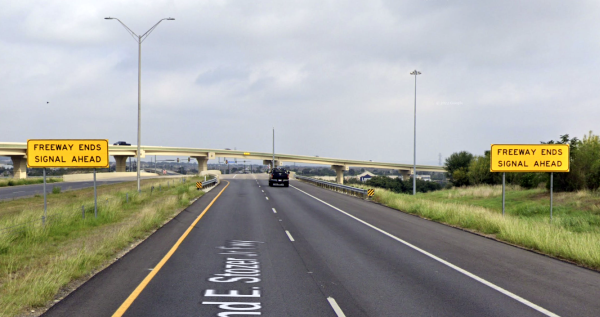|
||
|
|
||
This page last updated July 31, 2025 |
This page summarizes the history of various projects in the Loop 1604 - SH 151 - Alamo Ranch Parkway (ARP) - Westwood Loop area, discusses future plans, and answers frequently asked questions about this oft-maligned intersection.
The history of projects around this location illustrate the incremental method that road improvements often take and epitomizes the old addage "Don't let the perfect be the enemy of the good."

|
Looking for information about the current interchange construction? See the SH 151 Expansion Project page. |
On this page:
Jurisdictions
Many people just assume that either the City of San Antonio or TxDOT is responsible for all the roads in this area. However, that's not the case. TxDOT is responsible for SH 151 and Loop 1604 and their access roads. Bexar County is responsible for Alamo Ranch Parkway starting about 800 feet west of Loop 1604 (including the intersection at Westwood Loop), while TxDOT is responsible to the east of that point. There are signs on Alamo Ranch Parkway that mark where Bexar County's jurisdiction begins (see below.) The City of San Antonio is not responsible for any of the roads in this immediate vicinity.
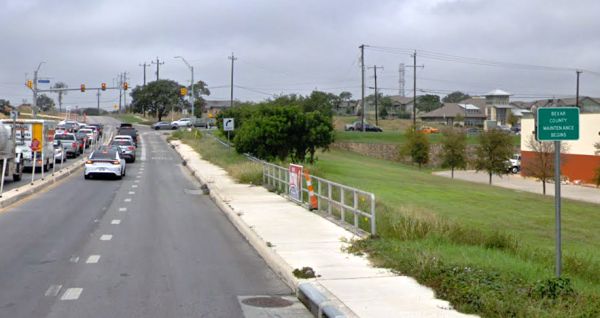
|
ADVERTISEMENT |
Project history (aka Why things are the way they are)
The flyover from Loop 1604 southbound to SH 151 eastbound removed all that traffic from the southbound access road and the previous signalized intersection required to cross Loop 1604 and enter SH 151. The new overpass connecting SH 151 to ARP provided a direct connection between those roadways. Prior to that, westbound traffic from 151 to ARP had to use the northbound 1604 access, take the turnaround at Culebra, then use the southbound 1604 access road to reach ARP. (See map below.)
The flyover and overpass allowed the previous signalized at-grade intersection on Loop 1604 at SH 151 to be removed, which was necessary in order to extend the Loop 1604 freeway to the south.
Work on this project began in April 2015. The flyover from southbound Loop 1604 to SH 151 opened to traffic July 30, 2016. The ARP overpass opened on December 17, 2016.
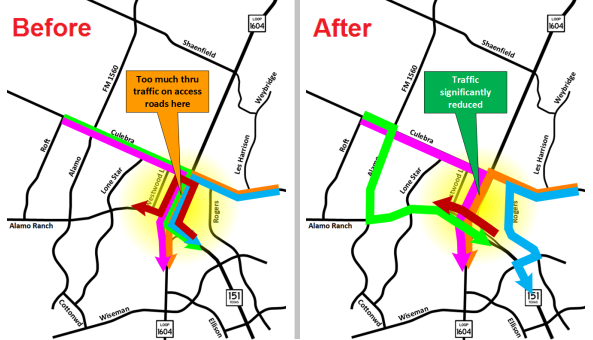
Suggestions for a "split-phase" signal were considered but dropped after modeling showed that the increased signal cycle time required for it would substantially increase congestion on all approaches.
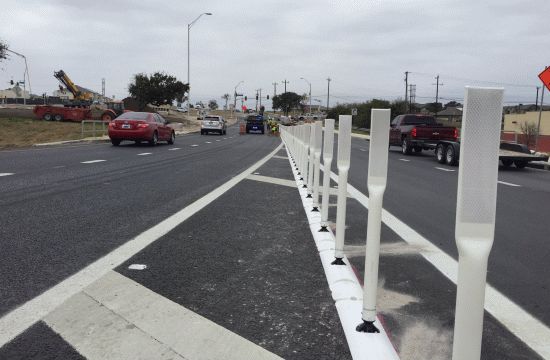
Future projects
TxDOT is in the midst of a study for a long-term expansion and other improvements for Loop 1604. That study is investigating adding an eastbound ARP/151 connector to northbound Loop 1604. This study is still underway and there is currently no funding, and thus no timeline.
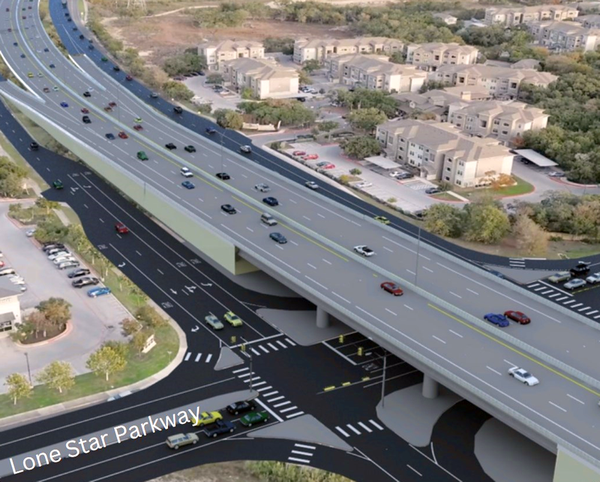
of Alamo Ranch Pkwy. could look like at Lone Star Pkwy.
FAQ
- Why did they make a highway end at a traffic signal? No place else has this.
It may seem like the highway ends at a signal since the 151 mainlanes continue straight onto Alamo Ranch Parkway (ARP), but the point of the overpass from 151 was to provide a direct connection from 151 to ARP, and ARP was already a surface street with signalized intersections, so that's just how it worked out.
This situation is not unique and is found in most other large cities.
SH 151 actually ends at Loop 1604. Since ARP lies directly ahead of the end of 151, the route to connect to it must inherently go straight. Therefore, it gives the impression that the highway keeps going over 1604 and Westwood Loop and then encounters a signal, but you'll notice that the speed limit decreases to 45 mph as you approach Loop 1604, and there are large yellow "FREEWAY ENDS/SIGNAL AHEAD" signs that tell you the freeway is ending and that you are transitioning to a surface street. There's even a green "Alamo Ranch Pkwy (straight arrow)" sign. Therefore, the overpasses are really just a long, straight exit from 151 to ARP instead of being a traditional exit to the right or left. Don't nearly all exits from highways end at a traffic signal or stop sign? So there's no reason for this one not to as well. Furthermore, with the addition of the overpass at Westwood Loop, traffic from SH 151 now is winnowed down to a single lane and merges onto ARP more like a typical exit ramp, which also should signal to drivers that they've exited the freeway.
This is a case where drivers need to pay attention and adjust their expectations accordingly. - This configuration causes westbound traffic from 151 to back up when it reaches ARP.
Indeed, traffic queues at the signal at Lone Star Parkway, but this happens anywhere traffic leaves a freeway and encounters a signalized intersection such as on exit ramps and access roads elsewhere in the city, and where freeways end and become surface roads (for example, southbound Loop 1604 at US 90). As mentioned above, this is essentially an exit from 151 to ARP — it just happens to be a straight exit at the end of 151. As such, there's no reason to expect this location wouldn't have backups like any other highly-trafficked exit from a freeway to a surface road.
Furthermore, traffic backed up there prior to the overpasses being built, and it was never claimed nor intended that the overpasses would solve that. Instead, the overpass from 151 is a significant improvement over the previous circuitous route from 151 to ARP via the Loop 1604 access roads and Culebra turnaround, and the Westwood Loop overpass has solved the previous problem of numerous crashes caused by illegal turning there as it was intended to do.
The cause of the congestion is simply that the signals at Lone Star Parkway cannot provide sufficient throughput for the peak traffic volume on ARP. The wide median on ARP makes it very difficult to design an efficient signal cycle. The same problem existed on Wurzbach Parkway at NW Military Hwy., and a project that was completed there in 2022 realigned the left turns to allow for more efficient signal phasing. A similar project here — or perhaps another innovative intersection design — could provide relief and were evaluated in a recent traffic study. However, that study ultimately recommended building overpasses instead. - Why didn't they extend the overpass over Westwood Loop when the overpass from 151 was built?
There were a few reasons. First, the state's right-of-way doesn't extend that far, so this intersection was outside the scope of that project aside from some incidental work. In addition, it would have increased the cost of that project, which had a limited budget. And, frankly, planners just did not expect the issues that manifested there. Road improvements in fast growing areas with limited funding will always be an exercise in incremental improvements and some trial and error. - Why didn't they build an eastbound overpass at Westwood Loop when they built the westbound overpass?
The westbound overpass over Westwood Loop was built specifically to solve the issue of westbound drivers making illegal turns onto Westwood Loop and causing crashes, and so it was awarded safety funding on that basis. The process to obtain funding requires demonstrating that the proposed project will solve an identified problem; an eastbound overpass in this case would not have done anything to solve the westbound illegal/unsafe turning issue, and there wasn't a similar issue on the eastbound side, so that’s why an eastbound overpass wasn’t included. - Are there any plans for an eastbound overpass at the intersection of ARP and Westwood Loop?
The county recently completed a study that recommended a Wurzbach Parkway-style roadway with overpasses in the median of the existing Alamo Ranch Parkway. This project includes eastbound overpass at Westwood Loop. The county is currently in the preliminary stages of design and engineering of this project with construction possibly starting in mid 2027. - What other improvements were considered for ARP and Westwood Loop?
A proposal to convert the intersection to an "RCUT" configuration was considered as was a proposal to change the westbound signals to a "split-phase" where the approaches from SH 151 and Loop 1604 would each have had their own green time, thus allowing left and right turns from each lane (similar to the McCullough exit from southbound I‑35 downtown). It was determined that changing to a split-phase would have extended the signal cycle length considerably (essentially increasing it from a four-way to a five-way intersection), thereby increasing wait times by up to 20% in all directions. - Why don't they extend SH 151 west from Loop 1604?
A proposal for a regional toll road system in 2009 would have extended SH 151 west to SH 211 as a toll road. However, it was determined not to be feasible and was dropped from the plans. (All toll projects in Bexar County were subsequently abandoned after increases in state highway funding in the mid 2010s.)
Extending the SH 151 designation west of Loop 1604 would require TxDOT to take over the route, something that the state currently has no interest in doing. Some believe that's what is needed in order to upgrade Alamo Ranch Parkway; however, that's not the case. The Alamo Area Mobility Authority — which is a local transportation agency created and overseen by Bexar County and has funding capabilities the county does not have — has the ability to upgrade ARP to a freeway without the route being designated as SH 151 and, indeed, such plans are already in the works as mentioned elsewhere on this page. - I heard/remember that an endangered spider caused this mess.
Not really, and in fact, it actually made things better. The initial plan for that area was for SH 151 to pass under Loop 1604 and then intersect the southbound Loop 1604 access road at ARP at a signalized intersection (see schematic below). The discovery of a small cave containing the federally-protected endangered Bracken Cave meshweaver spider during excavation for the underpass forced TxDOT to stop work and redesign the project. The revised project instead changed it to an overpass which protected the area of the karst habitat of that spider. With regards to traffic flow, the redesign actually was better than the original proposal for several reasons:
- First, in the original project, the east-west roadway connecting SH 151 to ARP would have crossed the southbound Loop 1604 access road at a signalized intersection, meaning traffic on one of those roadways would have a red signal while traffic on the other roadway crossed. You can imagine the backups this would cause today, not only on 151 and ARP approaching that intersection, but also on the southbound access road. Today, of course, the east-west traffic goes completely over the access road, and the only signal is for the westbound to southbound Loop 1604 left turn, which only stops eastbound traffic briefly. Westbound traffic from 151 to ARP does not have to stop at all nor does traffic on the southbound access road. This is obviously a major improvement over the original plan.
- Secondly, the flyover from southbound Loop 1604 to 151 was not included in the original project. In that original project, traffic on southbound Loop 1604 wanting to get to eastbound 151 would have exited onto the southbound Loop 1604 access road just south of Culebra and then made a left turn at the aforementioned signalized intersection to go under Loop 1604 and onto SH 151. However, while the project was being redesigned, additional funding became available to include the flyover in the revised project. (Technically, it was added to a separate project to upgrade Loop 1604 to a freeway in that area that was already underway.) To be fair, that flyover would have been built at some point, but the forced redesign of the original project expedited it.
So actually, in the end, the spider resulted in a substantially better outcome.
An interesting footnote to this story is that it was later determined the Bracken Cave meshweaver spider was not a unique species and instead was actually a Madla Cave meshweaver. As a result, the Bracken Cave meshweaver was removed from the endangered species list in 2022. But, the Madla Cave meshweaver itself was on the list, so the spider found at 151 and 1604 is still considered an endangered species. - Why didn't they plan for the increase in traffic caused by the original (Loop 1604) overpass?
In theory, the new overpass would only be carrying the traffic that was already going from SH 151 to ARP via the convoluted access road route, so it really shouldn't have increased traffic. But improving that connection also likely triggered something known as "latent demand". This when a significant number of people were using alternate routes to avoid the congestion and/or inconvenience of the previous 151 to ARP route, but after the new overpass opened, they started using it since it was now better than their previous route (or at least perceived to be). While planners can do studies to attempt to estimate what that latent demand might be, it's virtually impossible for anyone without a crystal ball to know for sure what that demand is until the new road opens and that traffic materializes, especially in an area like Alamo Ranch that's growing so rapidly. - Why is there a signalized intersection for the ramp to southbound Loop 1604 instead of a flyover?
There was not enough funding for a flyover for that connection, and, given the road network in this part of the city, planners estimated that there should not be a considerable amount of traffic making that turn (at least, not enough to justify the cost of a flyover), so this was the compromise. Furthermore, the peak period for traffic making that turn is in the evening when eastbound ARP/151 traffic is typically lighter. Traffic counts on that ramp since it has opened have validated planners' assumptions. - Why didn't they make the flyover from southbound 1604 to 151 two lanes?
Funding for that connector was limited. Furthermore, there are not enough lanes downstream on 151 to receive two lanes from the connector plus the lanes coming from ARP plus the entrance ramp from northbound 1604. Making that connector two lanes would have resulted in a pretty significant bottleneck where it merges into 151. That said, a future upgrade to that connector is being studied. - Why did they close the Wiseman exit ramp on eastbound SH 151?
Technically, there wasn't an exit there before. Traffic coming from Loop 1604 previously was on the access road and could either enter the SH 151 mainlanes just before Wiseman or stay on the access road to Wiseman. The new connector from 1604 enters the 151 mainlanes directly and not the access road, so it bypasses that earlier option. - Okay, then why didn't they add an eastbound exit to Wiseman?
The reason why they didn't add an eastbound exit to Wiseman from the Loop 1604 flyover is because there isn't sufficient space to do so. From the end of the on-ramp coming from northbound 1604, they would need a minimum of 1,500 feet for a weave area that would be safe and minimize possible conflicts. At the 1,500 foot mark, the exit to Wiseman would be quite steep and would put the end of that off-ramp much too close to the Wiseman intersection (less than 500 feet). This would require drivers wanting to turn right onto Wiseman to make a sharp cut across the access road, which might be difficult if more than a few vehicles were stopped at the signal, and that close proximity would mean that traffic would likely frequently back up onto the exit ramp. - Why did they have that sharp hairpin/hook connector from 151 to northbound 1604?
The answer to that is in the FAQ on the SH 151 expansion project page. - Why didn't they build/are there plans for a flyover or ramp from eastbound ARP to northbound Loop 1604?
There are two reasons such a ramp was not built as part of the original project here — there was not enough funding or demand for it. They used the funding they did have on the most urgent need — the southbound 1604 to eastbound 151 connector. It's also not included in the current project that's building the new westbound 151 to northbound 1604 connector. That said, it is being studied for possible future improvements to the Loop 1604 corridor. - Why is there no entrance to SH 151 from Culebra?
The decision to not include an entrance from Culebra to SH 151 was based on several factors:
- There is only room for one surface ramp in that area and the cost for a "braided" ramp was prohibitive.
- There are reasonable alternatives to get to SH 151 from Culebra whereas there are very limited possibilities to get from southbound 1604 to ARP that don't add significantly to existing congestion (i.e. southbound Loop 1604 at Culebra).
- An entrance from Culebra onto the SH 151 connector would have resulted in significant congestion on the connector during most of the day caused by the stream of slower-moving traffic entering from Culebra trying to merge into a single lane with the stream of faster-moving traffic coming from Loop 1604, all while moving uphill to the connector. This congestion would have backed-up onto Loop 1604 as well as onto the access road and possibly into the intersection at Culebra.
- They should fire the idiot who designed this.
If after reading the information above you still feel that way, see this page.
